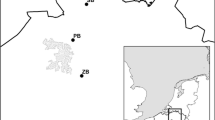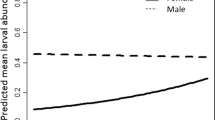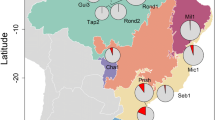Abstract
Parasites are typically concentrated on a few host individuals, and identifying the mechanisms underlying aggregated distribution can facilitate a more targeted control of parasites. We investigated the infestation patterns of hard ticks and chigger mites on two rodent species, the striped field mouse, Apodemus agrarius, and the lesser ricefield rat, Rattus losea, in Taiwan. We also explored abiotic and biotic factors that were important in explaining variation in the abundance of ticks and chiggers on rodent hosts. Ticks were more aggregated than chiggers on both rodent species. Factors important for the variation in parasitic loads, especially biotic factors, largely differed between ticks and chiggers. Variation partitioning analyses revealed that a larger proportion of variation in chiggers than in ticks can be explained, especially by abiotic factors. If, as proposed, the higher number of parasites in males is due to a larger range area or immunity being suppressed by testosterone, when A. agrarius males host more ticks, they are expected to also host more chiggers, given that chiggers adopt a similar host finding approach to that of ticks. Instead, the similar abundance of chiggers in male and female A. agrarius implies that a large home range or suppressed immunity does not predispose males to inevitably host more parasites. More variations were explained by abiotic than biotic factors, suggesting that controlling practices are more likely to be successful by focusing on factors related to the environment instead of host traits. Our study indicated that the extent of parasitism is rarely determined by a sole factor, but is an outcome of complex interactions among animal physiology, animal behavior, characteristics of parasites, and the environments.



Similar content being viewed by others

Data availability
No datasets were generated or analysed during the current study.
References
Agresti A (2002) Categorical Data Analysis. Wiley, Hoboken, New Jersey
Beati L, Keirans JE (2001) Analysis of the systematic relationships among ticks of the genera Rhipicephalus and Boophilus (Acari: Ixodidae) based on mitochondrial 12S ribosomal DNA gene sequences and morphological characters. J Parasitol 87:32–48
Boyer N, Réale D, Marmet J, Pisanu B, Chapuis JL (2010) Personality, space use and tick load in an introduced population of siberian chipmunks Tamias sibiricus. J Anim Ecol 79:538–547
Brunner JL, Ostfeld RS (2008) Multiple causes of variable tick burdens on small-mammal hosts. Ecology 89:2259–2272
Calabrese JM, Brunner JL, Ostfeld RS (2011) Partitioning the aggregation of parasites on hosts into intrinsic and extrinsic components via an extended Poisson-gamma mixture model. PLoS ONE 6:e29215
Combes C (2001) Parasitism: the Ecology and evolution of intimate interactions. University of Chicago Press, Chicago, p 728
Devevey G, Brisson D (2012) The effect of spatial heterogenity on the aggregation of ticks on white-footed mice. Parasitology 139:915–925
Ferreri L, Giacobini M, Bajardi P, Bertolotti L, Bolzoni L, Tagliapietra V, Rizzoli A, Rosà R (2014) Pattern of tick aggregation on mice: larger than expected distribution tail enhances the spread of tick-borne pathogens. PLoS Comput Biol 10:e1003931
Harrison A, Scantlebury M, Montgomery WI (2010) Body mass and sex-biased parasitism in wood mice Apodemus sylvaticus. Oikos 119:1099–1104
Kawamura A, Tanaka H, Takamura A (1995) Tsutsugamushi Disease: an overview. University of Tokyo, Tokyo
Krasnov BR, Bordes F, Khokhlova IS, Morand S (2012) Gender-biased parasitism in small mammals: patterns, mechanisms, consequences. Mammalia 76:1–13
Kuo CC, Huang CL, Wang HC (2011a) Identification of potential hosts and vectors of scrub typhus and tick-borne spotted fever group rickettsiae in eastern Taiwan. Med Vet Entomol 25:169–177
Kuo CC, Wang HC, Huang CL (2011b) The potential effect of exotic pacific rats Rattus exulans on vectors of scrub typhus. J Appl Ecol 48:192–198
Kuo CC, Wang HC, Huang CL (2011c) Variation within and among host species in engorgement of larval trombiculid mites. Parasitology 138:344–353
Kuo CC, Huang JL, Lin TE, Wang HC (2012a) Detection of Rickettsia spp. and host and habitat associations of fleas in eastern Taiwan. Med Vet Entomol 26:341–350
Kuo CC, Huang JL, Shu PY, Lee PL, Kelt DA, Wang HC (2012b) Cascading effect of economic globalization on human risks of scrub typhus and tick-borne rickettsial diseases. Ecol Appl 22:1803–1816
Lester RJ, Blomberg SP (2021) Three methods to measure parasite aggregation using examples from Australian fish parasites. Methods Ecol Evol 12:1999–2007
Li J, Wang D, Chen X (1997) Trombiculid mites of China: studies on vector and pathogen of tsutsugamushi disease. Guangdong Science and Technology Publishing, Guangzhou, China. [In Chinese.]
Lin JW, Lo HY, Wang HC, Shaner PJL (2014) The effects of mite parasitism on the reproduction and survival of the Taiwan field mice (Apodemus semotus). Zool Stud 53:79
Lindsø LK, Anders JL, Viljugrein H, Herland A, Stigum VM, Easterday WR, Mysterud A (2023) Individual heterogeneity in ixodid tick infestation and prevalence of Borrelia burgdorferi sensu lato in a northern community of small mammalian hosts. Oecologia 203:421–433
Lutermann H, Medger K, Horak IG (2012) Abiotic and biotic determinants of tick burdens in the eastern rock sengi (Elephantulus myurus). Med Vet Entomol 26:255–262
Matthee S, McGeoch MA, Krasnov BR (2010) Parasite-specific variation and the extent of male-biased parasitism; an example with a South African rodent and ectoparasitic arthropods. Parasitology 137:651–660
Morrill A, Nielsen ÓK, Skírnisson K, Forbes MR (2022) Identifying sources of variation in parasite aggregation. PeerJ 10:e13763
Mowry S, Keesing F, Fischhoff IR, Ostfeld RS (2019) Predicting larval tick burden on white-footed mice with an artificial neural network. Ecol Infor 52:150–158
Ostfeld RS, Miller MC, Hazler KR (1996) Causes and consequences of tick (Ixodes scapularis) burdens on white-footed mice (Peromyscus leucopus). J Mammal 77:266–273
Overall JE, Tonidandel S (2004) Robustness of generalized estimating equation (GEE) tests of significance against misspecification of the error structure model. Biom J 46:203–213
Peig J, Green AJ (2009) New perspectives for estimating body condition from mass/length data: the scaled mass index as an alternative method. Oikos 118:1883–1891
Poulin R (1993) The disparity between observed and uniform distributions: a new look at parasite aggregation. Int J Parasitol 23:937–944
Randolph SE (2014) Biology of Ticks Vol. 2 (2nd edition). In: Sonenshine DE, Roe RM, editors. Ecology of non-nidicolous ticks. New York, Oxford University Press; pp. 3–38
Randolph SE, Miklisova D, Lysy J, Rogers DJ, Labuda M (1999) Incidence from coincidence: patterns of tick infestations on rodents facilitate transmission of tick-borne encephalitis virus. Parasitology 118:177–186
Schalk G, Forbes MR (1997) Male biases in parasitism of mammals: effects of study type, host age, and parasite taxon. Oikos 78:67–74
Shaw DJ, Dobson AP (1995) Patterns of macroparasite abundance and aggregation in wildlife populations: a quantitative review. Parasitology 111:S111–133
Smith AT, Krasnov BR, Horak IG, Ueckermann EA, Matthee S (2023) Ectoparasites associated with the Bushveld gerbil (Gerbilliscus leucogaster) and the role of the host and habitat in shaping ectoparasite diversity and infestations. Parasitology 150:792–804
Teng KF, Jiang ZJ (1991) Economic insect fauna of China. Fasc 39. Acari. Ixodidae. Editorial Committee of Fauna Sinica, Academic Sinica. Science, Beijing, China. [In Chinese.]
Tucker MA, Ord TJ, Rogers TL (2014) Evolutionary predictors of mammalian home range size: body mass, diet and the environment. Glob Ecol Biogeogr 23:1105–1114
Wang PY, Wang ZT (2001) Telemetry-tracked range and movements of Bandicota indica and Rattus losea in sugarcane field. [In Chin ] Rep Taiwan Sugar Res Inst 174:15–34
Wang DQ, Yu ZZ (1992) Chigger mites of the genus Leptotrombidium: key to species and their distribution in China. Med Vet Entomol 6:389–395
Wilson K, Bjørnstad ON, Dobson AP, Merler S, Poglayen G, Randolph SE, Read AF, Skorping A (2002) Heterogeneities in macroparasite infections: patterns and processes. Pp.6–44 in The Ecology of Wildlife Diseases (Hudson PJ, Rizzoli AP, Grenfell BT, Heesterbeek JAP and Dobson AP eds), Oxford University Press, Oxford, UK
Woolhouse ME, Dye C, Etard JF, Smith T, Charlwood JD, Garnett GP, Hagan P, Hii JX, Ndhlovu PD, Quinnell RJ, Watts CH (1997) Heterogeneities in the transmission of infectious agents: implications for the design of control programs. Proc Natl Acad Sci 94:338–342
Zduniak M, Serafini S, Wróbel A, Zwolak R (2023) Host body mass, not sex, affects ectoparasite loads in yellow-necked mouse Apodemus flavicollis. Parasitol Res 122:2599–2607
Zeger SL, Liang KY (1986) Longitudinal data analysis for discrete and continuous outcomes. Biometrics: 121–130
Acknowledgements
We thank HY Wu and her students for logistical support during the field work.
Funding
This study was financially supported by the University of California, Davis, the Pacific Rim Research Program, the American Society of Mammalogists, and Taiwan Centers for Disease Control (DOH96-DC-2019). This article was subsidized by the National Taiwan Normal University (NTNU), Taiwan, ROC.
Author information
Authors and Affiliations
Contributions
C.C.K. conceived the study; C.C.K. and J.L.H. collected the data; C.C.K. performed statistical analyses and prepared for the figures; C.C.K. wrote the first draft of the manuscript; H.C.W. supervised and secured funding for the study. All authors read and approved the final manuscript.
Corresponding authors
Ethics declarations
Ethical approval
All procedures were approved by the University of California, Davis, Animal Use and Care Administrative Advisory Committee, and fulfilled Taiwanese legislative requirements.
Conflict of interest
The authors declare no conflict of interests.
Additional information
Publisher’s Note
Springer Nature remains neutral with regard to jurisdictional claims in published maps and institutional affiliations.
Rights and permissions
Springer Nature or its licensor (e.g. a society or other partner) holds exclusive rights to this article under a publishing agreement with the author(s) or other rightsholder(s); author self-archiving of the accepted manuscript version of this article is solely governed by the terms of such publishing agreement and applicable law.
About this article
Cite this article
Kuo, CC., Huang, JL. & Wang, HC. Parasite infestation patterns differ between ticks and chigger mites on two rodent host species in Taiwan. Exp Appl Acarol (2024). https://doi.org/10.1007/s10493-024-00918-3
Received:
Accepted:
Published:
DOI: https://doi.org/10.1007/s10493-024-00918-3



